Abstract
The present study explores intonational patterns in spontaneous speech in Peruvian Amazonian Spanish (PAS). The data came from 12 monolingual Spanish speakers in the city of Pucallpa, where the Spanish language has historically been in contact with the Amazonian language Shipibo-Konibo. The speakers responded to an open-ended prompt that elicited broad focus declaratives. Acoustic information from 1524 pitch accents was extracted from 194 sentences and analyzed using Praat. The analysis focused on five features: F0 rises, F0 peak alignment, downstepping, final lowering, and cases of stress clash. The results not only supported previous research on this variety that came from read speech tasks (e.g., F0 peaks consistently aligned with the stressed syllable), but also highlighted the importance of using multiple methodologies to gain a more comprehensive understanding of PAS prosody. Specifically, the varied sentence lengths and structures common in spontaneous speech provided new insights into downstepping, final lowering, and stress clash in PAS intonation. Overall, these results contribute to the growing literature on Spanish prosody in shared linguistic spaces and lend support for trends (such as F0 peak alignment) that have been reported in other language contact varieties.
1. Introduction
This paper examines the intonational patterns of broad focus declaratives in Peruvian Amazonian Spanish (henceforth, PAS) using spontaneous speech. Groundbreaking works on Spanish intonation have been traditionally based on laboratory (read) speech data (de la Mota 1997; Face 2001; Hualde 2002; Prieto et al. 1996; Sosa 1999; among others). These works have provided general and insightful descriptions of how Spanish behaves at the intonational level. More recently, researchers have examined Spanish intonation using spontaneous speech data (e.g., Rao 2009; Colantoni 2011; Barnes and Michnowicz 2013; Michnowicz and Barnes 2013; Henriksen et al. 2016; Muntendam and Torreira 2016; Froemming and Rao 2021; Korfhagen et al. 2021), or a combination of laboratory and spontaneous speech data (e.g., Sosa 2003; Henriksen 2009). Examining both types of data in intonational studies is not arbitrary. In fact, Face (2003) identifies differences between laboratory and spontaneous speech in Madrid Spanish. For instance, Face finds that in spontaneous speech data, it is more common to find stressed syllables without a pitch accent. Generally speaking, in Spanish, stressed syllables in content words analyzed using laboratory speech data do exhibit a pitch accent. The purpose of the present study is twofold: to phonetically explore the intonational patterns of PAS broad focus declaratives in spontaneous speech and to complement what has been reported in previous PAS works. By doing so, this study aims to enhance our understanding of Spanish intonation in nonreading tasks and of PAS, a variety that has been historically, and still is, in contact with Amazonian languages.
The research on PAS has flourished in recent years (e.g., Jara 2012; Vallejos 2014; and references therein). Part of this research boom on PAS was recently compiled in two volumes edited by Fafulas (2020) and Jara et al. (2023). At the intonational level specifically, we now know more about PAS than we did a decade ago. We have a basic understanding of some of the intonational patterns of PAS in different Amazonian cities: Iquitos (Vásquez and Velásquez 2019; Elías-Ulloa 2020), La Merced (Elías-Ulloa 2023), and Pucallpa (García 2011, 2016, 2023; Elías-Ulloa 2015). Interestingly, all these works have examined PAS intonation using laboratory speech. Working with laboratory speech data as a first approximation to the intonational patterns of a language, or language variety, is useful. For instance, researchers can control linguistic variables (e.g., segmental composition and syntactic structures). To the best of my knowledge, no work on PAS has examined its intonational patterns using unscripted data. The present study aims to fill this gap by providing an initial examination of PAS spontaneous speech in broad focus declaratives as spoken in Pucallpa, Peru.
The city of Pucallpa is the capital of the Coronel Portillo province in the Ucayali region of Peru. According to the 2017 national census, Coronel Portillo is the most populated province in Ucayali, with 384,168 inhabitants (INEI 2018). Linguistically, Spanish and Shipibo-Konibo, an Amazonian language part of the Panoan linguistic family, are the two main languages presently spoken in the Coronel Portillo province. Specifically, Coronel Portillo has 21,170 speakers of Shipibo-Konibo. This is significant, given that in Ucayali, there are approximately 24,667 speakers of Shipibo-Konibo (Ministerio de Educación 2018). Furthermore, around 91% of the population of the Coronel Portillo province reported Spanish as their first language, followed by Shipibo-Konibo at 6%, and other languages at 3% (including Quechua and Ashaninka) (INEI 2018). Although there is a significant presence of the Shipibo-Konibo language in the Ucayali region, it is important to note that most inhabitants are, or identify themselves as, monolingual speakers of Amazonian Spanish (Solís Fonseca 2003).
This paper is organized as follows: In Section 2, I outline some of the theoretical background followed in the present study. In Section 3, I describe the materials and the methods used in the present investigation. In Section 4, I present the results, and in Section 5, I provide a discussion of the main findings and their significance in the ongoing research on PAS intonation, and the larger conversation on analyzing Spanish intonation using spontaneous speech data. Some concluding remarks are included in Section 6.
2. Background
2.1. Autosegmental–Metrical Model
In this section, I will briefly describe the basic tenets of the autosegmental–metrical (AM) model of intonation (Pierrehumbert 1980; Beckman and Pierrehumbert 1986; Beckman et al. 2002; Ladd 2008), which I follow in the present study. In the AM model, intonational contours consist mainly of two basic units: pitch accents and edge tones. Phonologically, pitch accents are associated with the stressed syllables of content words, while edge tones mark the phrase boundaries. In this model, high (H) and low (L) are two of the most common phonological targets. Phonetically, tones correlate with movements in the fundamental frequency (F0) that accompany intonational contours. An F0 peak in the intonational contour, for example, represents a high tone (H), whereas an F0 valley represents a low tone (L). In an utterance, pitch accents can appear in two positions. If a pitch accent is in the final position of an intonational phrase, it is commonly referred to as nuclear. Pitch accents located in nonfinal positions are referred to as prenuclear. Edge tones, on the other hand, can mark intermediate phrases (ip; notated by a − sign) or intonational phrases (IP; notated by a % sign). Pitch accents can be monotonal (e.g., L or H) or bitonal (e.g., L+H or H+L).
It is important to note that the AM model assumes two levels of phrasing: intermediate phrases and intonational phrases (Beckman and Pierrehumbert 1986). Intermediate phrases are smaller than intonational phrases, and their meaning depends on the rest of the intonational phrase. In Spanish, intonational phrases are easy to identify. They usually end in clear pauses and show a final lengthening (Sosa 1999; Rao 2010). Identifying intermediate phrases is less straightforward, but some cues include short pauses and F0 continuation rises (D’Imperio et al. 2005; Prieto 2006). With regard to intermediate phrases, Sosa (1999) and Beckman et al. (2002) argue that they are not necessary in Spanish. Nibert (2000) and Hualde (2002) argue in favor of them. Nibert (2000), for example, shows that intermediate phrases can be helpful when trying to disambiguate the meaning of sentences with identical syntactic structures. Previous works on PAS have not provided compelling evidence in favor of intermediate phrases (cf. Elías-Ulloa 2023), because they have focused primarily on relatively simple sentences. Having said that, the present study explores spontaneous speech for the first time in this variety, and syntactically complex phrases are part of the analyzed data. In Section 5, I theorize how phrasing can be useful to explain some of the complexities of analyzing spontaneous speech.
In (1) and (2), I provide examples of how pitch accents and edge tones are distributed in an utterance, following the AM model. In both utterances, the word idea bears the nuclear accent. The other words in bold contain the prenuclear accents. Observe that example (1) contains an intermediate phrase boundary (at the word detalles), and this is marked with H−, while example (2) simply represents an intonational phrase.
| (1) | Sin | conocer | los | detalles, | ella | entendió | la | idea. |
| [[ | L+H | L+H H−] | [L+H | L+H | H+L L%]] | |||
| (2) | Ella | entendió | la | idea | ||||
| [L+H | L+H | H+L L%] |
F0 peaks in intonational contours can undergo two phonetic processes: downstep and upstep. A downstep refers to the lowering of an F0 peak in strict reference to a previous F0 peak. Oppositely, if the F0 reaches a peak higher than a preceding peak, we find an upstep. Furthermore, content words may not exhibit a pitch accent at all; that is, a content word may lack a noticeable F0 movement over the stressed syllable. When this happens, a word is described as deaccented.
Stemming from the AM model, researchers of Spanish intonation have put forth the Spanish in the Tones and Break Indices (Sp_ToBI) transcriptional system to describe and analyze the intonational patterns found in several Spanish varieties (Beckman et al. 2002; Face and Prieto 2007; Estebas Vilaplana and Prieto 2008; Hualde and Prieto 2015). On what follows, I will present some of the Sp_ToBI transcriptional system conventions, as they are useful in describing some of the patterns previously reported in PAS. For a comprehensive summary of all pitch accents and edge tones proposed for Spanish, however, the reader is referred to the work of Hualde and Prieto (2015). Additionally, Prieto and Roseano (2010) compile investigations of the intonational patterns of ten Spanish varieties.
In terms of pitch accents, Sp_ToBI recognizes two monotonal tones: L* and H*. The start (*) in ToBI indicates which tone is phonologically associated with the stressed syllable. Generally, the pitch accent L* is used to represent a low plateau in the F0 contour over the stressed syllable. The pitch accent H* is used to represent a high plateau in the F0 contour over the stressed syllable.
There are also four bitonal pitch accents: L+<H*, L+H*, L*+H, and H+L* (following Hualde and Prieto 2015). Crucially for our purposes, two of these bitonal pitch accents are distinguished by the location of the F0 peak. Specifically, in L+<H*, the F0 peak is reached after the stressed syllable and is commonly referred to as a late peak alignment. In the latest proposal by Hualde and Prieto (2015), the symbol < indicates the displacement of the F0 peak to the post-stressed syllable. This F0 peak displacement to the post-stressed syllable is commonly found in prenuclear accents of broad focus declaratives across several Spanish varieties (Prieto et al. 1995; Sosa 1999; Beckman et al. 2002; among others). When the F0 peak is realized within the boundaries of the stressed syllable, this is referred to as an early peak alignment. This early peak alignment is generally found in the nuclear position or when a word is highlighted in the discourse (i.e., it bears narrow/contrastive focus) (e.g., Face 2001, 2002a). Importantly, in both pitch accents, the high tone H is associated with the stressed syllable. We must also note that the pitch accents L*+H and H+L* have been reported in some Spanish varieties. In L*+H, there is a low tone throughout the stressed syllable, and the F0 contour starts to rise in the posttonic syllable. In H+L*, there is an F0 fall occurring during the stressed syllable.
Previous works on the PAS variety spoken in Pucallpa have only attested two pitch accents in terms of F0 peak alignment in broad focus declaratives: late peak alignment and early peak alignment (García 2011). In Figure 1, I provide schematic representations of these two bitonal pitch accents following Aguilar et al. (2009). In these images, the gray areas represent the stressed syllables.
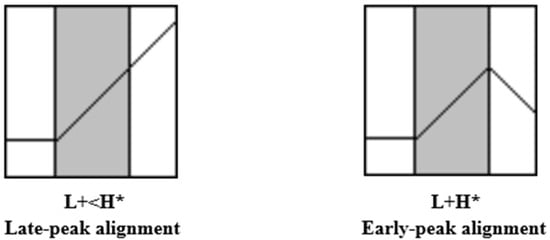
Figure 1.
Schematic representations of two bitonal pitch accents (adapted from Aguilar et al. 2009). The labels (L+<H* and L+H*) follow Hualde and Prieto (2015).
2.2. Spontaneous vs. Laboratory Speech
Works on Spanish intonation analyzing spontaneous speech data have become increasingly more common in recent decades. Providing an exhaustive list of these works is beyond the goals of the present study, but some of these studies will be discussed, because they help situate the current study into a larger context. The work of Face (2003) is one of the first studies to explicitly examine the intonational patterns of Spanish in spontaneous speech data. One of the main observations made by Face was that in spontaneous speech, phrasing is much more complex than in laboratory speech. Broadly speaking, the elicitation of laboratory data prompts simpler syntactic structures and similar (if not identical) utterances among speakers. By analyzing 150 declarative sentences extracted from a corpus of Madrid Spanish, Face found that 30% of content words were deaccented. Unlike what occurs in laboratory speech, where there is a pitch excursion in almost all content words, several content words in spontaneous speech data lack a pitch accent. Regarding the location of F0 peaks, Face showed that 25% of prenuclear accents in spontaneous speech exhibit an early peak alignment. This is noteworthy, because except for words bearing narrow/contrastive focus and broad focus declaratives in varieties where Spanish is in contact with other languages (e.g., Elordieta 2003, for Basque; O’Rourke 2005, for Quechua; Colantoni 2011, for Italian), prenuclear accents are typically characterized by a late peak alignment. Face also reported that a downstep and final lowering (i.e., where the height of the final F0 peak is lower than a preceding F0 peak) are not as common in spontaneous speech as they are in laboratory speech.
Examining wh-questions across four Spanish varieties, Sosa (2003) also identified differences between laboratory and spontaneous speech data. In read speech, speakers of Puerto Rican and Venezuelan Spanish showed a preference for falling contours at the end of wh-questions, whereas speakers of Mexican and Colombian Spanish preferred a rising contour. In spontaneous speech (elicited through interviews), Sosa found that one speaker from Mexico produced only falling contours, and that Colombian speakers produced both falling and rising contours. Interestingly, Puerto Rican and Venezuelan speakers produced both types of contours at the end of wh-questions in spontaneous speech. Rao (2009) explored deaccenting in spontaneous speech in Barcelona Spanish and found that 23% of content words analyzed were deaccented (from a total of 2609 analyzed words). Like Face (2003), Rao reported that content words lacking a pitch accent are not uncommon in spontaneous speech data.
Henriksen (2009) examined wh-questions in Peninsular Spanish (León, Spain) in two task types: a reading task and a gap task-oriented dialogue (described as a “person identification task” by the author), the latter prompting more spontaneous speech. In the reading task, Henriksen found four patterns for wh-questions: ‘final rise’, ‘nuclear circumflex’, ’global falling’ (without a final rise), and ‘nuclear falling’. Interestingly, in the person identification task, only two contours were identified: ‘final rise’ and ‘nuclear circumflex’. The works of Face (2003), Sosa (2003), Rao (2009), and Henriksen (2009) not only show that differences in intonation between laboratory and spontaneous speech exist, but they also suggest that limiting our analysis to one speech style may not give us the complete picture of the intonational patterns in a language or language variety.
When specifically exploring Spanish spontaneous speech, most studies have examined F0 peak alignment in broad focus declaratives. In this type of utterance, no word is particularly highlighted or emphasized; the entire sentence is interpreted as new information by the listener. With regard to broad focus declaratives, Colantoni (2011) explored four varieties of Argentine Spanish. In prenuclear positions, Spanish speakers from Buenos Aires and the western province of San Juan (both contact varieties) preferred an early peak alignment, whereas speakers from northeastern Argentina and Córdoba (noncontact varieties) preferred a late peak alignment. Furthermore, in Buenos Aires Spanish, the range in which early peak alignment occurs was 80–100%. Likewise, Barnes and Michnowicz (2013) examined F0 peak alignment of prenuclear accents in Chipilo Spanish, a contact variety in Mexico. The results showed that the early peak alignment ranged between 34 and 70%, with an average of 53%. In another study, Michnowicz and Barnes (2013) investigated Yucatan Spanish and found that speakers produced an early peak alignment at a 64% overall rate. In the Andean variety of Spanish spoken in Cuenca, Ecuador, Froemming and Rao (2021) found that the F0 peak is realized within the boundaries of the stressed syllable in 70.39% of all pitch accents analyzed. Korfhagen et al. (2021) explored the intonation of broad focus declaratives in four Afro–Hispanic varieties: Chinchano Spanish (ChS), Chocó Spanish (CS), Chota Valley Spanish (CVS), and Yungueño Spanish (YS). They found that the F0 peak is aligned with the stressed syllable in all four contact varieties, ranging between 82–97%.
These studies are relevant to the present investigation for two reasons. First, and just like in the present study, these authors explore the intonation of broad focus declaratives using spontaneous speech data. Second, the Spanish varieties examined in these studies come from areas where Spanish is, or has been, in contact with other languages. As mentioned earlier, in the case of PAS, Shipibo-Konibo is the Amazonian language present in the Ucayali region of Peru, where the city of Pucallpa is located. Even though the participants in the present study are monolingual Spanish speakers born and raised in Pucallpa, the results of this study contribute to the ongoing research on the intonation of Spanish varieties that are, and have historically been, in contact with other languages.
2.3. Intonation of PAS Broad Focus Declaratives
García (2011) explored the intonation of Spanish monolingual speakers in the city of Pucallpa through a reading task. One of the main findings was that in prenuclear position, there was a preference for an early peak alignment; the F0 peak was realized within the boundaries of the stressed syllable, similar to other contact Spanish varieties such as Buenos Aires Spanish (Colantoni 2011) and Andean Spanish (O’Rourke 2005), to name a few. This intonational pattern was also found in the work of García (2016), which analyzed laboratory speech data of the same PAS variety. In addition to the early peak alignment in broad focus declaratives, García (2016) reported that, in cases of closed syllables, the F0 peak tends to align not only with the stressed syllable, but more specifically, the stressed vowel.
Figure 2 shows the intonational contour of a PAS broad focus declarative Lorena donaba la corona, as collected in a reading task by García (2016). Like all images in the present study, content words and stressed syllables are segmentally marked. In the upper tier, I include the tonal representations of pitch accents and edge tones following Sp_ToBI conventions. Notice that all three pitch accents are noticeable, and they all show an early peak alignment: L+H*. Furthermore, the high tone in the pitch accent of the word “donaba” exhibits a downstep movement and is shown here with the exclamation mark (!) before the H. The boundary tone of this utterance is L%.
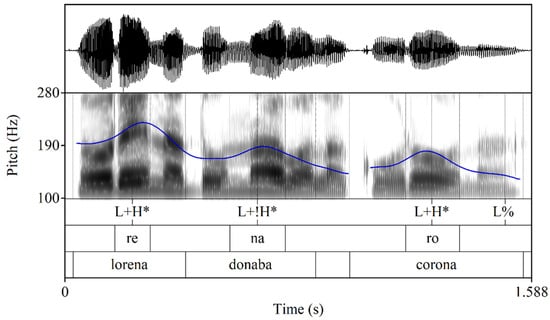
Figure 2.
Intonational contour of a PAS utterance from laboratory speech data. Lorena donaba la corona (‘Lorena was donating the crown’).
2.4. Stress Clash
Exploring intonation in spontaneous speech provided two additional nuances that were neither found nor explored in previous PAS works. For instance, in García (2011, 2016), the minimum and maximum of content words included in an utterance were three and five, respectively, and most utterances had a (complex)subject–verb–object–(adjunct) syntactic structure. Spontaneous speech data are much more diverse. The sentences analyzed in the present study varied in length and syntactically, yielding utterances such as Medio desordenada es Pucallpa (‘A little messy is Pucallpa’) or Empezamos a bailar pues nosotros ahí (‘We of course started to dance there’). I was also able to explore what intonational strategies come into play when there are no intervening syllables between two stressed syllables (‘stress clash’). In previous PAS works, all of them examining laboratory speech data, at least one intervening syllable was placed between two stressed syllables to avoid any effect on the phonetic realization of each pitch accent. In this study, however, I found cases of stress clash, and they are presented in Section 4.5. Now, I will briefly review studies that have purposely investigated cases of stress class in Spanish (manipulating the number of intervening syllables between tones in reading tasks). We must note that, in these studies, terms such as tonal crowding or tonal clash have been used to refer to the same phenomenon. I will use the term stress clash instead, because I only analyze cases where two stressed syllables appear next to each other without any intervening syllable.
The works of Prieto and colleagues were among the first ones to phonetically explore cases of stress clash in Spanish (Mexican Spanish), in relation to timing and F0 scaling. Prieto et al. (1995) found that their speakers used two different strategies in cases of stress clash. While one speaker produced two separate rising gestures (i.e., two F0 peaks), the other speaker produced a single rising gesture (i.e., one F0 peak). Furthermore, F0 peak location showed more variability than F0 valley locations. Whereas F0 peak location varied according to the number of intervening syllables between pitch accents, F0 valleys were constantly located at the onset of the stressed syllable. Investigating the same Spanish variety, Prieto and Shih (1995) showed that F0 valleys are indeed affected by stress clash. Specifically, the F0 valley of the first pitch accent was realized earlier in relation to the beginning of the stressed syllable, but much later in the second pitch accent. Prieto et al. (1996), exploring pitch downtrend in Mexican Spanish, found that stress clash was not a factor in the scaling of F0 peaks; the values remained constant regardless of the number of intervening syllables. In a subsequent study, Prieto (1998) reported effects of stress clash in F0 valleys. When there is not enough time between two F0 peaks, the F0 valley fails to be fully realized.
Face (2002b) examined stress clash in Castilian Spanish by manipulating the number of intervening syllables (ranging from 0 to 5 syllables) between pitch accents. In terms of timing, Face found that only the “border tones” (i.e., F0 peak of the first pitch accent and the F0 valley of the second pitch accent) are the most affected by stress clash. This difference, according to Face, distinguishes Castilian and Mexican Spanish involving stress clash given that in Mexican Spanish, the entire pitch accent is affected. With regard to scaling, Face reported three key findings: First, the value of the second F0 valley decreases as the number of intervening syllables increases, which is exactly what Prieto (1998) found. Second, the F0 peak value of the second pitch accent increases as the number of intervening syllables decreases. Third, when there are none or one intervening syllables, the F0 peak of the second pitch accent is higher than the F0 peak of the first pitch accent.
Thornberry (2014) used the same methodology as Face (2002b) to examine stress clash in Buenos Aires Spanish. Regarding timing, Thornberry found effects of stress clash in the F0 peak of the first pitch accent and the F0 valley of the second pitch accent (in ‘border tones’, as also found by Face 2002b). However, this temporal adjustment occurred only in extreme cases of stress clash (0–1 intervening syllables). Regarding scaling, the first pitch accent remained relatively unaffected, unlike the second pitch accent. Like Prieto (1998) and Face (2002b), Thornberry reported that the F0 peak value of the second pitch accent increases with less intervening syllables between pitch accents. Finally, in Buenos Aires Spanish, the second pitch accent is systematically lower than the first pitch accent, different to what Face (2002b) found in Castilian Spanish.
Although there are similarities between these studies, the effects of stress clash vary across Spanish varieties, and even within one variety (like in the case of Mexican Spanish). The studies from Mexican Spanish, Castilian Spanish, and Buenos Aires Spanish are fundamental to the present study, because the PAS data analyzed here also contain instances of stress clash. Unlike those previous studies, however, the present PAS data come from spontaneous speech, and I only analyze instances where there are no intervening syllables between two stressed syllables (i.e., extreme cases of stress clash). I report these findings on stress clash in PAS in Section 4.5.
A few caveats are necessary before continuing. The Amazonian Spanish variety examined in this paper comes from Peru, specifically from the city of Pucallpa. Therefore, the findings of this study do not necessarily apply to other Amazonian varieties found in Peru or Amazonian Spanish varieties from neighboring countries. As mentioned above, we now have a basic understanding of PAS broad focus declaratives at the intonational level. A logical next step in this research is to ask what the intonational patterns of PAS broad focus declaratives are in spontaneous speech data, and how they differ with those identified in laboratory speech data. I must also note that, in this paper, I do not favor one type of speech over the other (for support of laboratory speech, the reader is referred to Xu (2010). Not only are both speech data useful, but they are also necessary when exploring intonation (Face 2010).
2.5. Research Questions
The research questions that guide the present study are as follows: (1) What are the main patterns found in the spontaneous speech of PAS broad focus declaratives, regarding F0 rises, F0 peak alignment, downstepping, final lowering, and stress clash? (2) How do the findings from spontaneous speech complement what we already know about PAS intonation of broad focus declaratives?
3. Materials and Methods
The data in the present study come from 12 monolingual Spanish speakers born and raised in the city of Pucallpa, Peru. The data were collected during the summers of 2013 and 2014. Two speakers were recorded in 2013, and the rest of them (10 speakers), in 2014. The data used in this study were collected as a part of a larger project on the PAS variety spoken in Pucallpa. The participants were university students at the time of the interview, and their ages ranged from 18 to 30 years. In total, there were seven male speakers and five female speakers. The data were recorded using a Zoom H4 portable digital recorder and an external Shure WH30 condenser headset microphone with XLR connectors. The recordings were saved as WAV files and then transferred to a laptop.
To prompt spontaneous speech, all participants were asked to describe something about the city or about the people from Pucallpa. The interviewer was the author, and it was shared with the participants that the interviewer was new to Pucallpa and did not know much about the city, popular places to visit there, local traditions, etc. The participation of the interviewer was limited; that is, participants were the ones who spent most (if not all) of the time talking. Additionally, the participants had the liberty to talk about any topic they wanted and as long as they wished. Although one speaker spoke for 13:49 min, the speaking time of the rest of the speakers ranged from 1:05 min to 6:59 min.
As mentioned before, laboratory and spontaneous speech data differ greatly in several aspects. One of them is the complexity of the utterances. While the sentence length and structure are fixed in laboratory speech data, this is not the case in spontaneous speech data. In the present study, for instance, I found utterances with as few as two content words and utterances with as many as 28 content words. The segmental composition is another difference in these two types of speech data. In general, when working with laboratory speech data, researchers try to use words with voiced consonants in order to make F0 contours fully visible. In spontaneous speech, it is difficult to control the segmental composition of an utterance, since the words that speakers use may contain both voiced and voiceless consonants. The nature of the present data also yielded a variety of syllabic structures of the stressed syllable such as VCC, CVVV, CVCCC, and CCVC, among many others. Furthermore, not only the position of the stressed syllable in each word may vary, but also how many intervening syllables occur between two stressed syllables across words. In the present study, the content words were oxytone, paroxytone, and proparoxytone. Additionally, it was not uncommon to find two stressed syllables positioned immediately next to each other (i.e., extreme cases of stress clash) within a phonological phrase. Finally, cases of resyllabification were very prevalent in the spontaneous speech data examined here. For instance, que es (‘that is’) and dos años (‘two years’) were pronounced as [ˈkes] and [ˈdo.ˈsa.ɲos], respectively.
There was a total of 194 utterances included in the analysis. To be part of the analysis, utterances had to contain at least one conjugated verb. Utterances with several pauses/hesitations or without visible F0 contours or interrogatives, and utterances clearly bearing any type of narrow/contrastive focus were discarded. Overall, there were 1524 potential pitch accents across all 12 speakers. Given the nature of spontaneous data, it was not possible to collect a comparable number of sentences among speakers. While some participants were very loquacious during the interviews, others were more succinct. Participants were not given a time limit for their answers.
An acoustic analysis was carried out in Praat (Boersma and Weenink 2023). The beginning and end of all content words and their stressed syllables were marked following a close inspection of the spectrogram. Word and syllable boundaries were easily identified in the data, but the audio files were also used when marking these boundaries. The presence (or lack thereof) of a pitch accent was determined if there was a difference of at least 7 Hz (Hertz) between the start of the F0 rise and the F0 peak (a threshold also used by Willis 2002 and O’Rourke 2005). If the difference was less than 7 Hz, the pitch accent was characterized as deaccented. If the difference was 7 Hz or more, the pitch accent was described as noticeable. If a pitch accent was described as noticeable, the next step in the analysis was to determine if the F0 peak was reached within, before, or after the stressed syllable. To examine instances of downstep and final lowering, the height of the F0 peaks of each noticeable pitch accent was calculated in Hz. For final lowering, specifically, the height of the last pitch accent in an utterance was compared to the height of the previous F0 peak. If the height of the final utterance F0 peak was equal or higher than that of the previous F0 peak, the utterance showed no final lowering. If the height of the last F0 peak in the utterance was lower than the previous F0 peak, the utterance showed final lowering.
4. Results
4.1. F0 Rises
Generally speaking, pitch accents in Spanish broad focus declaratives exhibit an F0 rise. This F0 rise takes place during the stressed syllable (but see Armstrong (2010) for Caribbean Spanish), and the F0 peak may be reached in the same stressed syllable or after it. There are cases, however, where a pitch accent, although phonologically present, does not show a noticeable F0 rise at all.
An acoustic analysis of the present data revealed that 92.8% of the 1524 pitch accents showed an F0 rise during the stressed syllable. No F0 rises (i.e., deaccentuation) were found in 2.3% of the analyzed pitch accent tokens. In 4.9% of the cases, a falling pitch contour occurred during the stressed syllable.
Figure 3 illustrates a PAS intonational contour, where F0 rises can be seen in each content word. In this utterance, the speaker is describing one of the soccer teams from Pucallpa. We can observe that there is a rise in the F0 contour in the words “tenemos”, “buenos”, “jugadores”, “todos”, and “puestos”. Notice that, even in nuclear position (i.e., “puestos”), there is a noticeable F0 peak.
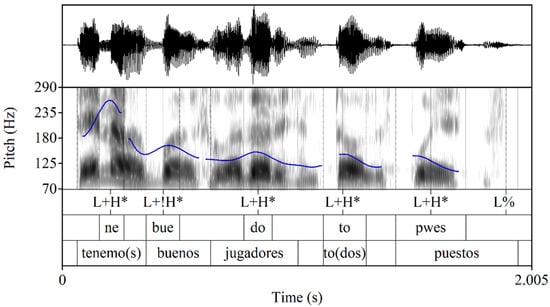
Figure 3.
Intonational contour of a PAS utterance. Tenemos buenos jugadores en todos los puestos (‘We have good players in all positions (on the field)’).
There were also cases where the content words did not exhibit a F0 rise. In the utterance presented in Figure 4, the speaker is talking about “El Tunche”, a popular legend in Peruvian Amazonia. We can observe that there is an F0 rise on the words “Tunche”, “va”, and “pasando”. However, there is no noticeable F0 peak on the word “es”.
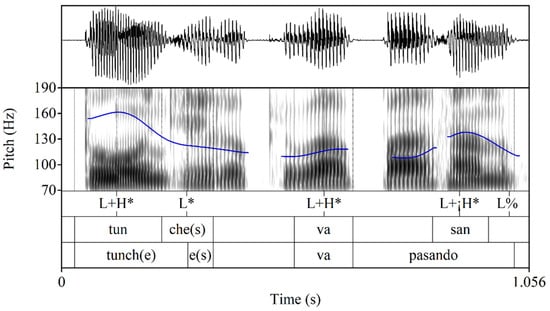
Figure 4.
Intonational contour of a PAS utterance. El Tunche es lo que va pasando (‘The Tunche is what is passing through’).
The pitch accent on the word “es” was analyzed as being deaccented (L*). It is worth noting that, in this utterance, the word “es” resyllabified with the last syllable of the word “Tunche”. Thus, there are no intervening syllables between these two consecutive stressed syllables. The deaccentuation in this case may be due to stress clash. An anonymous reviewer rightly pointed out that verbs and shorter words are more susceptible to deaccenting (Rao 2009). It is interesting to note that we find a similar instance in Figure 13 below, but instead, the verb “es” does show a noticeable F0 peak. I further discuss this, and other strategies for dealing with stress clash, in Section 4.5.
Additionally, there were instances where a falling F0 contour was present (H+L*). That is, instead of an F0 rise, the F0 contour descended during the stressed syllable. Figure 5 illustrates this F0 behavior. In this context, the speaker is describing the city of Pucallpa. We can observe that there is an F0 rise on the words “Pucallpa”, “lindo”, and “no”, but on the word “es”, the F0 contour descends throughout the stressed syllable until the onset of the following stressed syllable. This behavior may be due to the fact the word “es” contains only one syllable, and therefore, there is insufficient time for the F0 contour to fully complete an F0 rise.
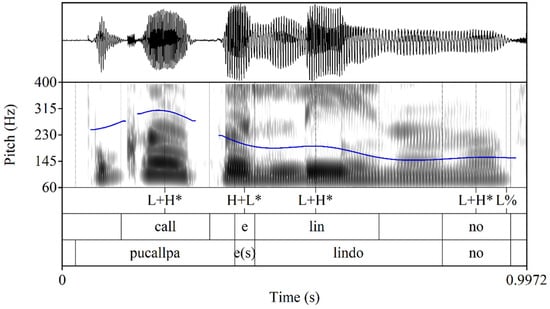
Figure 5.
Intonational contour of a PAS utterance. Pucallpa es lindo, ¿no? (‘Pucallpa is beautiful, isn’t it?’).
4.2. F0 Peak Alignment
One of the most studied phonetic features in Spanish has been F0 peak alignment. In the current study, I only examined pitch accents in a prenuclear position, because in Spanish, nuclear positions are characterized by the realization of the F0 peak within the boundaries of the stressed syllable, F0 suppression (i.e., final lowering, as previously described), or deaccentuation. Furthermore, I only examined those pitch accents with a noticeable F0 rise. These criteria yielded 1144 tokens for the analysis of F0 peak alignment. Table 1 below shows the distribution of F0 peak alignment for these tokens.

Table 1.
F0 peak alignment in prenuclear position.
Data show that the realization of the F0 peaks within the stressed syllable (L+H*) is the most common pattern, occurring in more than 96% of the tokens. In Figure 6, the speaker is talking about the traditional drink in Pucallpa. For almost all content words (“acá”, “bebida”, “así”, “tradicional”, and “masato”), the F0 peak is realized within the boundaries of the stressed syllable. Like the utterance in Figure 5, the only exception is the word “es”, where we see a falling contour through the stressed syllable. Again, in Section 4.5, I describe some of the strategies PAS speakers use to deal with extreme cases of stress clash. This pattern, a single F0 peak encompassing two stressed syllables immediately next to each other, represents one of those strategies in the present data.
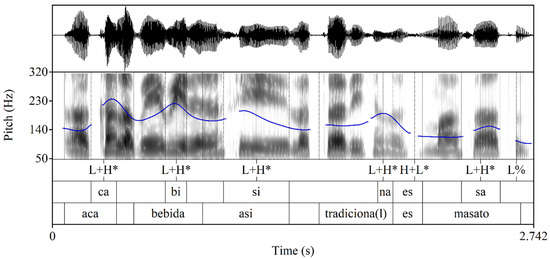
Figure 6.
Intonational contour of a PAS utterance. Acá la bebida así tradicional es masato (‘Here the traditional drink is Masato’).
When examining tonal alignment, 19 tokens showed an F0 rise throughout the stressed syllable (H*). These instances typically occurred in cases of stress clash, where two stressed syllables were next to each other. Figure 7 illustrates this pattern. The F0 contour starts to rise at the onset of the first stressed syllable “es” and continues its excursion until it reaches its peak in the next stressed syllable: “muy”.
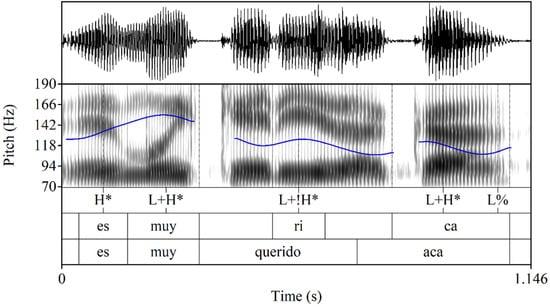
Figure 7.
Intonational contour of a PAS utterance. Es muy querido acá (‘It is very loved here’).
4.3. Downstepping
In the spontaneous data analyzed here, we can observe the systematic lowering of the F0 peak across short utterances (downstepping). That is, in short sentences, F0 peaks were lower than the previous one. In longer utterances, downstepping took on a different form, with phrasing appearing to play an important role. When multiple smaller phrases were present in an utterance, there was downstepping within the individual phrases, and a reset of the F0 peak height between phrases.
Figure 3 and Figure 7 illustrate downstepping within relatively short utterances. Figure 8 below shows an example of this “resetting” between intermediate phrases (ip). Across the whole utterance, it may seem that downstepping is not present, but if we look at the separate phrases (Le gusta celebrar, festejar a esa gente and También le gusta mucho el deporte, el fútbol), we see that downstepping does occur; it simply resets at the intermediate phrase boundary: También.

Figure 8.
Intonational contour of a PAS utterance. Le gusta celebrar, festejar a esa gente… También le gusta mucho el deporte, el fútbol (‘Those people like to celebrate, to party… They also like sports very much, soccer’).
4.4. Final Lowering
Related to downstepping, broad focus declaratives in read speech typically show that the nuclear pitch accent exhibits the lowest F0 peak of the utterance. This finding is not as consistent in the present spontaneous data of PAS. In total, there were 194 sentences, but six of them were discarded from this analysis because no F0 peak was visible in the last word of the utterance. Therefore, only 188 sentences were analyzed for final lowering.
Results revealed that 105 sentences (55.9%) showed a final lowering, while 83 sentences (44.1%) did not. Figure 3 and Figure 6 are examples of final lowering. Figure 9 below is an example where final lowering is not present. In this context, the speaker is talking about one of the main tourist attractions in the Ucayali region. In the utterance, the F0 peak on the word “velo” is 130 Hz, while the F0 peak of the nuclear accent “novia” is 143 Hz. The same pattern can be observed in Figure 4, where the F0 peak of the nuclear pitch accent is higher than the previous one.
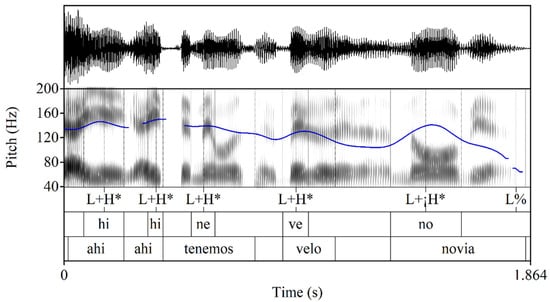
Figure 9.
Intonational contour of a PAS utterance. Ahí, ahí tenemos El Velo de la Novia (‘There, there, we have The Bride’s Veil [Waterfall]’).
4.5. Stress Clash: Preliminary Observations
Spontaneous speech ended up yielding multiple instances of extreme stress clash (n = 119), which was not present in previous PAS read speech works. These instances of stress clash—when there are two stressed syllables right next to each other—opened a new avenue of analysis for this variety. Preliminary analysis of stress clash in PAS showed that speakers use three main strategies to accommodate two stressed syllables positioned immediately next to each other: (1) one single F0 peak, (2) an extended F0 peak, and (3) two F0 peaks. In Table 2, I present the distribution of extreme stress clash strategies found in the analyzed data.

Table 2.
Strategies used by PAS speakers to resolve extreme cases of stress clash.
Let us expand on the first strategy: one single F0 peak. When there is one F0 peak in cases of stress clash, the most common pattern found is an F0 peak on the first stressed syllable and an F0 fall during the second stressed syllable (“peak and fall”). Figure 6 exemplifies this intonational pattern. In that example, two stressed syllables appear immediately next to each other: tradiciona(l) es. The F0 peak is reached within the boundaries of the first stressed syllable “na” (the lateral consonant was not pronounced), and the F0 contour falls during the second stressed syllable (“es”). I found 21 instances of this pattern.
The second most common pattern within the one single F0 peak strategy was an F0 rise throughout the first stressed syllable and the F0 peak reached in the second stressed syllable (“rise and peak”). We can observe this pattern in Figure 7 in the case of es muy, where there is an F0 rise throughout the first syllable (“es”), and the F0 contour reaches its peak in the second stressed syllable (“muy”). This pattern occurred in seven instances.
There were also cases where one of the F0 peaks was deaccented. In five instances, there was an F0 peak followed by a deaccented pitch accent (see Figure 4 for an example). After the F0 peak in the first stressed syllable, the F0 contour does not show any noticeable F0 peak during the second stressed syllable (“peak and deaccented”). Only in one instance did I find the opposite pattern (“deaccented and peak”). Finally, I identified four instances where there is an F0 fall during the first stressed syllable and an F0 peak within the boundaries of the second stressed syllable. Figure 5 shows this pattern (“fall and peak”). In that instance (es lindo), the F0 contour falls during the syllable “e(s)” until it rises again reaching its F0 peak in the syllable “lin”.
The second strategy PAS speakers use to resolve extreme cases of stress clash is what I call an extended F0 peak. The intonational contour in Figure 10 below shows an example of this second strategy. In this context, the speaker is talking about one soccer team from Pucallpa that had been playing in the second division for two consecutive years. The two words of interest are segundo año. The last syllable of the first word “segundo” is not pronounced; thus, what we hear is segu naño. Here, we see that the F0 peak in the first stressed syllable does not really fall, but rather, the F0 contour continues at a leveled height into the next stressed syllable. This creates an extended F0 peak across two consecutive stressed syllables. The F0 heights of the first and second stressed syllables are maintained at 163 Hz. The extended F0 peak strategy was found in 23 cases of the analyzed data.
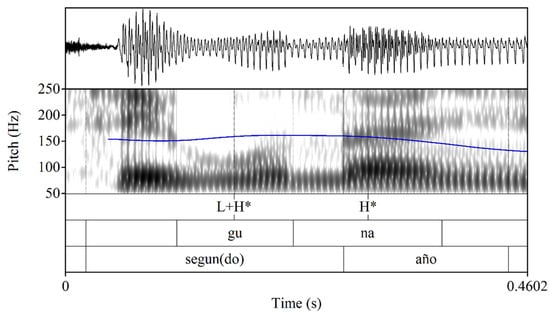
Figure 10.
Part of an intonational contour of a PAS utterance. Este es su segundo año en Segunda (‘This is its second year in the Second [Division]…’).
The third strategy is the phonetic realization of two F0 peaks, one for each stressed syllable. In these cases, the F0 contour reaches a peak in the first stressed syllable; it then falls before rising again until it reaches another peak in the second stressed syllable. Out of the three strategies, this is the most common one found in the analyzed data. Similar to the case of the one single F0 peak strategy, the two F0 peaks were not realized uniformly. Figure 11 shows what I am describing as “consecutive peaks”. In this context, the speaker is describing the city of Pucallpa. We can identify two consecutive stressed syllables: bien chévere. The F0 contour rises and falls during the first stressed syllable, and it reaches a comparable peak in the second stressed syllable (in the image, we cannot see the F0 rise, only the F0 peak). The heights of both F0 peaks are very similar: 239 Hz and 242 Hz. These “consecutive peaks” were found in 27 instances.
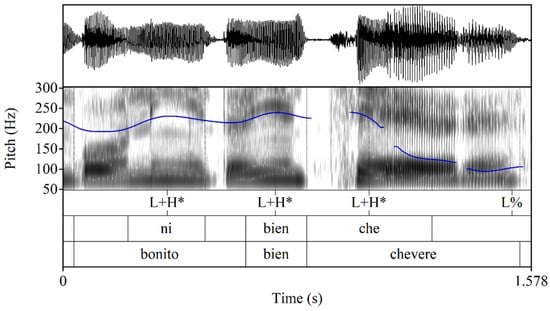
Figure 11.
Part of an intonational contour of a PAS utterance. Pucallpa es una ciudad bien bonito [sic], bien chévere (‘Pucallpa is a very beautiful city, very nice’).
Another intonational contour under this third strategy was an upstep movement. Figure 12 illustrates this pattern. In this context, the speaker ends his interview by saying that he has talked a lot already. There are two consecutive stressed syllables: hablé mucho. The F0 contour in the first stressed syllable (“blé”) reaches its peak at 168 Hz, while the F0 contour in the second stressed syllable (“mu”) reaches its peak at 180 Hz. Similar patterns of an upstep in extreme cases of stress clash were found in 17 instances.
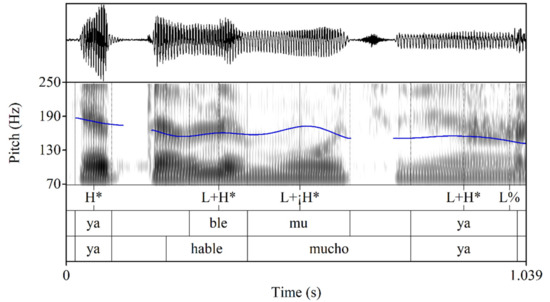
Figure 12.
Intonational contour of a PAS utterance. Ya te hablé mucho ya (‘I already told you a lot’).
The other pattern identified under this strategy was a downstep movement, which is exemplified in Figure 13. It is worth mentioning that this strategy is limited to instances where extreme cases of stress clash occur at the initial utterance position. In these cases, the value of the F0 peak in the second stressed syllable is not as high as the value of the F0 peak in the first syllable. Here, the utterance starts with the word “nuevo”, and the second word is “es”. The height of the first F0 peak is around 288 Hz, and the height of the second F0 peak (downstepped) is 177 Hz. This downstep pattern occurred in 14 instances.
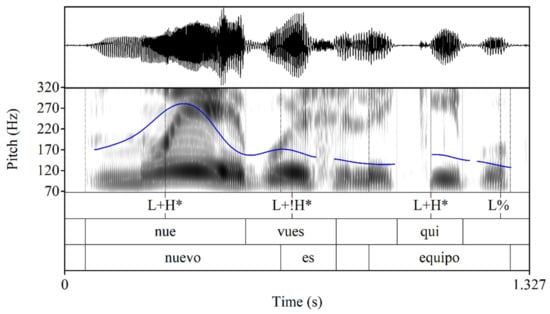
Figure 13.
Part of an intonational contour of a PAS utterance. Nuevo es el equipo… (‘The team is new…’).
5. Discussion
The present study has cast light on five intonational features found in broad focus PAS declaratives of spontaneous speech data: F0 rises, F0 peak alignment, downstepping, final lowering, and stress clash. To begin, the analysis of the F0 rises showed that deaccenting is not present in PAS spontaneous speech. F0 rises are widely common (92.8% of all pitch accents analyzed). This finding suggests that in PAS as spoken in Pucallpa, speakers consistently produce pitch accents across the whole utterance. This supports previous findings for PAS that found minimal deaccenting across declarative types (García 2023; this lack of deaccenting has also been reported in Afro–Hispanic varieties by Sessarego and Rao 2016 and Butera et al. 2020). Similarly, I found instances in which there was a F0 falling contour during the stressed syllable (H+L*), particularly in one-syllable words. In previous PAS studies using read speech data, content words contained at least two syllables, so one-syllable words were not considered as a testing ground for other PAS intonational contours. This finding seems to suggest that falling contours may indeed be part of the intonational repertoire of PAS broad focus declaratives. Future works on PAS will need to further explore this observation.
In the present study, F0 peaks consistently aligned with the stressed syllable (phonologically represented by L+H*). This finding not only helps to validate the findings of previous studies on the PAS variety spoken in Pucallpa (García 2011, 2016, 2023), but also the use of laboratory/read speech data when examining intonational patterns. It demonstrates that reading tasks can yield valid results, despite being highly controlled.
Interestingly, the F0 peak alignment analysis here also supports what other scholars have found; specifically, that early peak alignment occurs at a higher rate in Spanish contact varieties. As mentioned before, Buenos Aires Spanish shows this occurring at a rate of 80–100% (Colantoni 2011); Chipilo Spanish, at a rate of 34–70% (Barnes and Michnowicz 2013); Yucatan Spanish, at a rate of 64% (Michnowicz and Barnes 2013); Cuenca Spanish, at a rate of 70% (Froemming and Rao 2021); and Afro–Hispanic varieties, at a rate of 82–97% (Korfhagen et al. 2021). PAS provides additional evidence to support this trend, with the F0 peaks aligning within the stressed syllable at a very high rate: 96%. This raises interesting questions about language contact: To what extent might this be due to being a contact variety? To what extent is this higher rate due to the specific Amazonian language (Shipibo-Konibo) being in contact with Spanish, or simply being an instance of language contact more broadly? Since I do not have enough evidence from Shipibo-Konibo to tease apart the effect one language has over the other, and given that an early peak alignment is the preferred intonational pattern of broad focus declaratives, not only in the Spanish spoken in Pucallpa (in both spontaneous and read speech), but also in several Spanish contact varieties, I can only hypothesize that overall, an early peak alignment may be the one pattern Spanish speakers of language contact varieties resort to in neutral contexts (for a discussion of simplified intonational features in second language acquisition, see Sessarego and Rao 2016; Butera et al. 2020). Future research could shed light on the effects that specific languages may have (or may have had) on the F0 peak alignment in the Spanish spoken in the Amazonian region of Peru.
The present analysis also contributes to conversations about downstepping across the length of the utterance in spontaneous speech. The results showed that downstepping is present in short utterances, while in longer utterances, the heights of the F0 peaks appear to reset between smaller intermediate phrases (ip). A similar behavior from spontaneous speech data was reported in Madrid Spanish, where downstepping occurred only in parts of an utterance (Face 2003). These findings seem to suggest that the downstepping patterns we observe in spontaneous speech data may be related to the different (and complex) types of phrasing found in spontaneous speech.
When it comes to final lowering in the spontaneous speech in PAS, I did not find a consistent lowering in the nuclear accent. This is different from PAS findings from read speech data, where a final lowering was consistently found (García 2011, 2016, 2023). Similar trends were reported in the spontaneous speech from Madrid Spanish (Face 2003). In Madrid Spanish, it was not uncommon for the final F0 peak to be higher than the previous F0 peak. These findings, along with those from the present study, seem to indicate that downstepping and final lowering behave differently in less-controlled contexts such spontaneous speech. In the future, it would be interesting to explore the pragmatics behind why speakers sometimes exhibit a final lowering and sometimes do not. Future investigations could also explore how listeners in these varieties perceive the difference between utterances with a final lowering versus those without it.
Lastly, the examination of spontaneous speech provided an opportunity to analyze stress clash in a way that previous laboratory studies on PAS have not. The analysis showed that PAS speakers utilize three main strategies to resolve extreme cases of stress clash: one single F0 peak, an extended F0 peak, and two F0 peaks. These findings mirror what previous studies have found in other Spanish varieties. Prieto et al. (1995), for example, reported that one of their speakers produced one F0 peak (“a single rising gesture”), while the other produced two F0 peaks (“two separate rising gestures”). Face (2002b) reported that in extreme cases of stress clash, the F0 peak of the second stressed syllable tends to be higher than the F0 peak of the first syllable. In the present study, cases of upstep are also identified, where the value of the F0 peak of the second stressed syllable is higher than that of the previous F0 peak. Studies on stress clash in Buenos Aires Spanish read speech noted that speakers use multiple strategies, and often, the first pitch accent remains unaffected (Thornberry 2014), similar in some respects to what was found here. Future investigations into stress clash in PAS, however, are required. We must note that in the present study, only extreme cases of stress clash were analyzed. Laboratory speech tasks in PAS, where we can intentionally manipulate the number of intervening syllables between pitch accents, may provide more insight into stress clash and allow us to explicitly examine the effects of stress clash in terms of timing and the scaling of tones.
More broadly, this study contributes to the larger discussions about both methodologies and intonational contours in contact varieties of Spanish. In terms of methodology, the present findings highlight the benefits of using a spontaneous speech analysis to complement read speech analysis. When findings complement each other, as was the case with F0 peak alignment here, it validates both studies’ findings and their methodologies. Additionally, the present study shows that spontaneous speech can help us identify features that could be further examined in a more controlled/laboratory setting (i.e., stress clash).
When it comes to the larger body of literature on contact languages, this study reinforces some of the patterns found across contact situations in the Spanish-speaking world, specifically when it comes to tonal alignment in broad focus declaratives. The present findings raise important questions regarding whether these alignment patterns are the result of simply being contact varieties, a byproduct of universal processes of L2 acquisition (as claimed by Sessarego and Rao 2016; Butera et al. 2020), or if/how specific languages in contact impact the intonational patterns of PAS. One possible venue for future research would be to examine the speech patterns of bilinguals of Spanish and Shipibo-Konibo, and to see how those compare to the speech patterns of monolingual Spanish speakers in the area.
This study has, of course, some limitations. For instance, the utterances analyzed here come from spontaneous speech, where the speaker was simply asked a single, open-ended prompt question. This elicited a monologue-style response, which varied in length across speakers. Some speakers were loquacious in their responses, while others were more succinct. This also meant that not all speakers had a comparable number of potential sentences to be analyzed. In future studies, it would be interesting to see if these patterns hold, or if new patterns emerge, in a context where two speakers engage in back-and-forth dialogue, for example, and they are asked to negotiate some meaning.
Another limitation is the number and diversity of the speakers. All participants in the present study were university students between the ages of 18 and 30 during the time of the interview (summers of 2013 and 2014). Future studies on PAS spontaneous speech could include speakers across age groups, educational levels, and urban vs. rural areas. Spontaneous speech tasks may also allow us to include speech from speakers who have less literacy skills, and therefore, may not be able to participate in reading tasks. Additionally, an anonymous reviewer pointed out that a faster speech rate could provide less time for F0 excursions. Although speech rate was not a factor taken into consideration in the present study, this is a valid observation. Future studies on PAS spontaneous data might consider different rates as a factor, given that in Spanish, it has been claimed that speech rate affects the locations of tonal landmarks (e.g., Prieto and Torreira 2007).
Finally, I want to highlight a unique challenge of working with spontaneous speech. In this type of study, it was difficult to tease out the speaker’s intention versus the listener’s perception. For example, the speaker may have intended to emphasize a part of an utterance within their monologue, without necessarily conveying a type of focus (narrow/contrastive). That said, I viewed my prompt as inherently eliciting broad focus declaratives, since I told them that I did not know much about the city of Pucallpa, and speakers were not responding to specific questions, providing contrast or correction, etc. In the reading tasks, the difference between broad, narrow, and contrastive focus is clear, but it becomes less clear when analyzing spontaneous speech. This challenge, in my view, highlights the importance of complementing laboratory speech data with spontaneous speech data. An anonymous reviewer suggested that in future works, it would be useful to perform perceptual validation tests using snippets from the data set and ask PAS speakers if they perceive a particular type of focus, or any type of focus for that matter. It would also be interesting to include speakers of other Peruvian Spanish varieties in these perceptual studies, as they would give us insight into Peruvian Spanish as a whole.
6. Conclusions
The present study is a first approximation to the intonational patterns of broad focus declaratives in PAS spontaneous speech. Based on an acoustic analysis, I have examined five prosodic features: F0 rises, F0 peak alignment, downstepping, final lowering, and cases of stress clash. Overall, the findings presented in this paper advance our understanding of PAS intonational patterns using different methodologies, as well as contribute to the larger discussion about Spanish varieties that are currently, or have historically been, in contact with other languages.
Funding
This research received no external funding.
Institutional Review Board Statement
The study was conducted in accordance with the Declaration of Helsinki and approved by the Ohio State Behavioral and Social Sciences IRB (2012B0249, 19 June 2012).
Informed Consent Statement
Informed consent was obtained from all subjects involved in the study.
Data Availability Statement
Data are not available to the public. They are available upon request from the author.
Acknowledgments
I would like to express my sincere gratitude to two anonymous reviewers who provided me with thoughtful feedback and valuable suggestions. I would also like to acknowledge Erin O’Rourke for comments and thought-provoking questions while I was working on this paper, and for providing guidance on the creation of the images. For their questions and insights, I thank the audience of the Spanish Linguistics in North Carolina (SLINKI) Conference in 2019 where I presented preliminary findings of the present study. Thanks to the editors, Tim Face and Meghan Armstrong, and the entire editorial team, for their support. Finally, I want to wholeheartedly thank all the participants in Pucallpa for their time and willingness to participate. Any errors or shortcomings are my own.
Conflicts of Interest
The author declares no conflict of interest.
References
- Aguilar, Lourdes, Carme de la Mota, and Pilar Prieto. 2009. Sp_ToBI Training Materials. Available online: http://prosodia.upf.edu/sp_tobi/ (accessed on 27 June 2023).
- Armstrong, Meghan E. 2010. Puerto Rican Spanish intonation. In Transcription of Intonation of the Spanish Language. Edited by Pilar Prieto and Paolo Roseano. Munich: Lincom Europa, pp. 155–89. [Google Scholar]
- Barnes, Hilary, and Jim Michnowicz. 2013. Peak alignment in semi-spontaneous bilingual Chipilo Spanish. In Selected Proceedings of the 6th Workshop on Spanish Sociolinguistics. Edited by Ana M. Carvalho and Sara Beaudrie. Somerville: Cascadilla Proceedings Project, pp. 109–22. [Google Scholar]
- Beckman, Mary, and Janet Pierrehumbert. 1986. Intonational structure in Japanese and English. Phonology Yearbook 3: 255–309. [Google Scholar] [CrossRef]
- Beckman, Mary, Manuel Díaz-Campos, Julia McGory, and Terrell A. Morgan. 2002. Intonation across Spanish, in the Tones and Break Indices Framework. Probus 14: 9–36. [Google Scholar] [CrossRef]
- Boersma, Paul, and David Weenink. 2023. Praat: Doing Phonetics by Computer, Version 6.3.10. Available online: http://www.praat.org/ (accessed on 3 May 2023).
- Butera, Brianna, Rajiv Rao, and Sandro Sessarego. 2020. Afro-Peruvian Spanish declarative intonation: Analysis and implications. In Hispanic Linguistics: Current Issues and New Directions. Edited by Alfonso Morales-Front, Michael J. Ferreira, Ronald P. Leow and Cristina Sanz. Amsterdam: John Benjamins, pp. 230–47. [Google Scholar]
- Colantoni, Laura. 2011. Broad-focus declaratives in Argentine Spanish contact and non-contact varieties. In Intonational Phrasing at the Interfaces: Cross-Linguistic and Bilingual Studies in Romance and Germanic. Edited by Gabriel Christoph and Conxita Lleó. Amsterdam: John Benjamins, pp. 183–212. [Google Scholar]
- de la Mota, Carme. 1997. Prosody of sentences with contrastive new information in Spanish. In Intonation: Theory, Models and Applications: Proceedings of an ESCA Workshop. Edited by Antonis Botinis, Georgios Kouroupetroglou and George Carayiannis. Athens: ESCA/University of Athens, pp. 75–78. [Google Scholar]
- D’Imperio, Mariapaola, Gorka Elordieta, Sónia Frota, Pilar Prieto, and Marina Vigário. 2005. Intonational phrasing in Romance: The role of syntactic and prosodic structure. In Prosodies. Edited by Sónia Frota, Marina Vigário and João Freitas. Berlin: Mouton de Gruyter, pp. 59–98. [Google Scholar]
- Elías-Ulloa, José. 2015. The intonational patterns of yes-no questions in the Amazonian Spanish of Shipibo-Konibo speakers. PAPIA 25: 47–75. [Google Scholar]
- Elías-Ulloa, José. 2020. Interrogative intonation in monolingual Amazonian Spanish: The case of Spanish spoken in the cities of Pucallpa and Iquitos. In Amazonian Spanish: Language Contact and Evolution. Edited by Stephen Fafulas. Amsterdam: John Benjamins, pp. 191–221. [Google Scholar]
- Elías-Ulloa, José. 2023. Tonal units and their phonological behavior in Amazonian Spanish from La Merced (Peru): An exploration of the intonational patterns of declarative and interrogative sentences. In Spanish Diversity in the Amazon: Dialect and Language Contact Perspectives. Edited by Margarita Jara, Roberto Zariquiey, Pilar M. Valenzuela and Anna María Escobar. Leiden and Boston: Brill, pp. 121–61. [Google Scholar]
- Elordieta, Gorka. 2003. The Spanish intonation of speakers of a Basque pitch-accent dialect. Catalan Journal of Linguistics 2: 67–95. [Google Scholar] [CrossRef]
- Estebas Vilaplana, Eva, and Pilar Prieto. 2008. La notación prosódica del español: Una revisión de Sp_ToBI. Estudios de Fonética Experimental 17: 263–83. [Google Scholar]
- Face, Timothy L. 2001. Focus and early peak alignment in Spanish intonation. Probus 13: 223–46. [Google Scholar] [CrossRef]
- Face, Timothy L. 2002a. Local intonational marking of Spanish contrastive focus. Probus 14: 71–92. [Google Scholar] [CrossRef]
- Face, Timothy L. 2002b. When push comes to shove: Tonal crowding in Madrid Spanish. The Linguistic Association of Korea Journal 10: 77–100. [Google Scholar]
- Face, Timothy L. 2003. Intonation in Spanish declaratives: Differences between lab speech and spontaneous speech. Catalan Journal of Linguistics 2: 115–31. [Google Scholar] [CrossRef]
- Face, Timothy L. 2010. The necessity of both naturally-occurring and elicited data in Spanish intonational phonology. Studies in Hispanic and Lusophone Linguistics 3: 485–99. [Google Scholar] [CrossRef]
- Face, Timothy L., and Pilar Prieto. 2007. Rising accents in Castilian Spanish: A revision of Sp_ToBI. Journal of Portuguese Linguistics 2: 117–46. [Google Scholar] [CrossRef]
- Fafulas, Stephen, ed. 2020. Amazonian Spanish: Language Contact and Evolution. Amsterdam: John Benjamins. [Google Scholar]
- Froemming, Brenda, and Rajiv Rao. 2021. The tritonal pitch accent in the broad focus declaratives of the Spanish spoken in Cuenca, Ecuador: An acoustic and sociolinguistic analysis. Estudios de Fonética Experimental 30: 119–40. [Google Scholar]
- García, Miguel. 2011. The Intonational Patterns of the Peruvian Amazonian Spanish (PAS). Master’s thesis, Stony Brook University, Stony Brook, NY, USA. [Google Scholar]
- García, Miguel. 2016. The Intonation of Peruvian Amazonian Spanish: Rising Accents and Segmental Factors. Ph.D. thesis, The Ohio State University, Columbus, OH, USA. [Google Scholar]
- García, Miguel. 2023. Focus marking in the intonation of Peruvian Amazonian Spanish. In Spanish Diversity in the Amazon: Dialect and Language Contact Perspectives. Edited by Margarita Jara, Roberto Zariquiey, Pilar M. Valenzuela and Anna María Escobar. Leiden and Boston: Brill, pp. 86–120. [Google Scholar]
- Henriksen, Nicholas. 2009. Wh-question intonation in Peninsular Spanish: Multiple contours and the effect of task type. Journal of Portuguese Linguistics 8: 45–73. [Google Scholar] [CrossRef]
- Henriksen, Nicholas, Meghan E. Armstrong, and Lorenzo García-Amaya. 2016. The intonational meaning of polar questions in Manchego Spanish spontaneous speech. In Intonational Grammar in Ibero-Romance. Edited by Meghan E. Armstrong, Nicholas Henriksen and Maria del Mar Vanrell. Amsterdam: John Benjamins, pp. 181–205. [Google Scholar]
- Hualde, José I. 2002. Intonation in Spanish and the other Ibero-Romance languages. In Romance Phonology and Variation. Edited by Caroline Wiltshire and Joaquim Camps. Philadelphia: John Benjamins, pp. 101–15. [Google Scholar]
- Hualde, José I., and Pilar Prieto. 2015. Intonational variation in Spanish: European and American varieties. In Intonation in Romance. Edited by Sónia Frota and Pilar Prieto. Oxford: Oxford University Press, pp. 350–91. [Google Scholar]
- INEI (Instituto Nacional de Estadística e Informática). 2018. Resultados Definitivos del Departamento de Ucayali (Tomo 1). Lima. Available online: https://www.inei.gob.pe/media/MenuRecursivo/publicaciones_digitales/Est/Lib1554/25TOMO_01.pdf (accessed on 10 October 2023).
- Jara, Margarita. 2012. Peruvian Amazonian Spanish: Linguistic variation, language ideologies and identities. Sociolinguistic Studies 6: 445–69. [Google Scholar] [CrossRef]
- Jara, Margarita, Roberto Zariquiey, Pilar Valenzuela, and Anna María Escobar, eds. 2023. Spanish Diversity in the Amazon: Dialect and Language Contact Perspectives. Leiden and Boston: Brill. [Google Scholar]
- Korfhagen, David, Rajiv Rao, and Sandro Sessarego. 2021. Declarative intonation in four Afro-Hispanic varieties: Phonological analysis and implications. In Aspects of Latin American Spanish Dialectology: In honor of Terrell A. Morgan. Edited by Manuel Díaz-Campos and Sandro Sessarego. Philadelphia: John Benjamins, pp. 155–79. [Google Scholar]
- Ladd, D. Robert. 2008. Intonational Phonology, 2nd ed. Cambridge: Cambridge University Press. [Google Scholar]
- Michnowicz, Jim, and Hilary Barnes. 2013. A sociolinguistic analysis of pre-nuclear peak alignment in Yucatan Spanish. In Selected Proceedings of the 15th Hispanic Linguistics Symposium. Edited by Chad Howe, Sarah E. Blackwell and Margaret Lubbers Quesada. Somerville: Cascadilla Proceedings Project, pp. 221–35. [Google Scholar]
- Ministerio de Educación. 2018. Lenguas Originarias Del Peru. Lima: MINEDU. Available online: https://centroderecursos.cultura.pe/sites/default/files/rb/pdf/Lenguas%20Originarias%20del%20Peru%20%282018%29_7_MB.pdf (accessed on 10 October 2023).
- Muntendam, Antje, and Francisco Torreira. 2016. Focus and prosody in Spanish and Quechua: Insights from an interactive task. In Intonational Grammar in Ibero-Romance. Edited by Meghan E. Armstrong, Nicholas Henriksen and Maria del Mar Vanrell. Amsterdam: John Benjamins, pp. 69–90. [Google Scholar]
- Nibert, Holly. 2000. Phonetic and Phonological Evidence for Intermediate Phrasing in Spanish Intonation. Ph.D. thesis, University of Illinois, Urbana-Champaign, IL, USA. [Google Scholar]
- O’Rourke, Erin. 2005. Intonation and Language Contact: A Case Study of two Varieties of Peruvian Spanish. Ph.D. thesis, University of Illinois, Urbana-Champaign, IL, USA. [Google Scholar]
- Pierrehumbert, Janet. 1980. The Phonetics and Phonology of English Intonation. Ph.D. thesis, MIT, Cambridge, MA, USA. [Google Scholar]
- Prieto, Pilar. 1998. The scaling of the L values in Spanish downstepping contours. Journal of Phonetics 26: 261–82. [Google Scholar] [CrossRef]
- Prieto, Pilar. 2006. Phonological phrasing in Spanish. In Optimality-Theoretic Studies in Spanish Phonology. Edited by Fernando Martínez-Gil and Sonia Colina. Amsterdam: John Benjamins, pp. 39–60. [Google Scholar]
- Prieto, Pilar, and Chilin Shih. 1995. Effects of tonal clash on downstepped H* accents in Spanish. Paper presented at EUROSPEECH’95: Fourth European Conference on Speech Communication and Technology 2, Madrid, Spain, September 18–21; pp. 1307–10. [Google Scholar]
- Prieto, Pilar, and Francisco Torreira. 2007. The segmental anchoring hypothesis revisited: Syllable structure and speech rate effects on peak timing in Spanish. Journal of Phonetics 35: 473–500. [Google Scholar] [CrossRef]
- Prieto, Pilar, and Paolo Roseano, eds. 2010. Transcription of Intonation of the Spanish Language. Lincom Studies in Phonetics 6. München: LINCOM Europa. [Google Scholar]
- Prieto, Pilar, Chilin Shih, and Holly Nibert. 1996. Pitch downtrend in Spanish. Journal of Phonetics 24: 445–73. [Google Scholar] [CrossRef]
- Prieto, Pilar, Jan van Santen, and Julia Hirschberg. 1995. Tonal alignment patterns in Spanish. Journal of Phonetics 23: 429–51. [Google Scholar] [CrossRef]
- Rao, Rajiv. 2009. Deaccenting in spontaneous speech in Barcelona Spanish. Studies in Hispanic and Lusophone Linguistics 2: 31–75. [Google Scholar] [CrossRef]
- Rao, Rajiv. 2010. Final lengthening and pause duration in three dialects of Spanish. In Selected Proceedings of the 4th Conference on Laboratory Approaches to Spanish Phonology. Edited by Marta Ortega-Llebaria. Somerville: Cascadilla Proceedings Project, pp. 69–82. [Google Scholar]
- Sessarego, Sandro, and Rajiv Rao. 2016. On the simplification of a prosodic inventory: The Afro-Bolivian Spanish case. In Inquiries in Hispanic Linguistics: From Theory to Empirical Evidence. Edited by Alejandro Cuza, Lori Czerwionka and Daniel Olson. Amsterdam: John Benjamins, pp. 171–90. [Google Scholar]
- Solís Fonseca, Gustavo. 2003. Lenguas en la Amazonía Peruana. Lima: Visual Service S.R.L. [Google Scholar]
- Sosa, Juan Manuel. 1999. La entonación del español. Madrid: Cátedra. [Google Scholar]
- Sosa, Juan Manuel. 2003. Wh-questions in Spanish: Meaning and configuration variability. Catalan Journal of Linguistics 2: 229–47. [Google Scholar] [CrossRef]
- Thornberry, Philip A. 2014. Tonal crowding effects in Buenos Aires Spanish: An experimental study. Studies in Hispanic and Lusophone Linguistics 7: 369–94. [Google Scholar] [CrossRef]
- Vallejos, Rosa. 2014. Peruvian Amazonian Spanish: Uncovering variation and deconstructing stereotypes. Spanish in Context 11: 425–53. [Google Scholar] [CrossRef]
- Vásquez, Alonso, and Héctor Velásquez. 2019. El arranque tritonal en el español amazónico de Iquitos. Lexis XLIII 43: 561–86. [Google Scholar] [CrossRef]
- Willis, Erik. 2002. Is there a Spanish imperative intonation revisited: Local considerations. Linguistics 40: 347–74. [Google Scholar] [CrossRef]
- Xu, Yi. 2010. In defense of lab speech. Journal of Phonetics 38: 329–36. [Google Scholar] [CrossRef]
Disclaimer/Publisher’s Note: The statements, opinions and data contained in all publications are solely those of the individual author(s) and contributor(s) and not of MDPI and/or the editor(s). MDPI and/or the editor(s) disclaim responsibility for any injury to people or property resulting from any ideas, methods, instructions or products referred to in the content. |
© 2024 by the author. Licensee MDPI, Basel, Switzerland. This article is an open access article distributed under the terms and conditions of the Creative Commons Attribution (CC BY) license (https://creativecommons.org/licenses/by/4.0/).